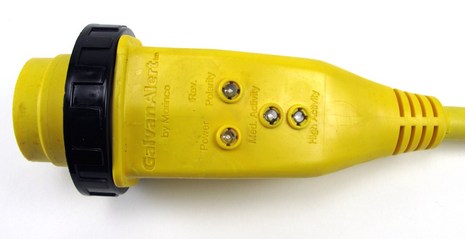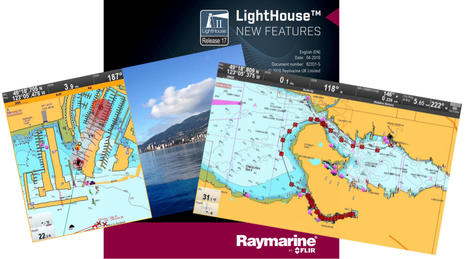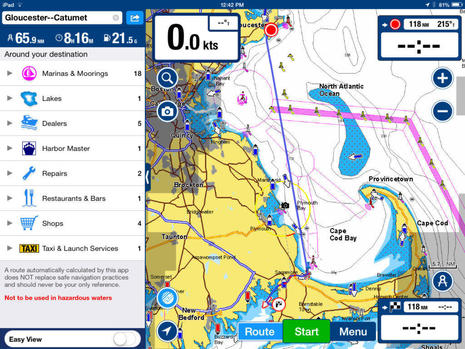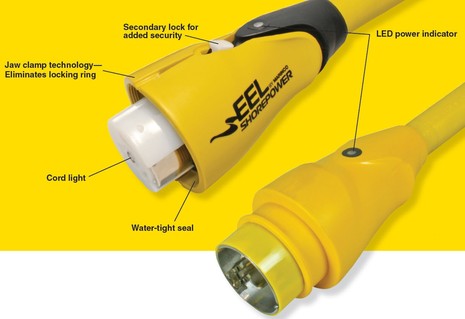Shore power #1, Marinco GalvanAlert
I’ve had a Marinico GalvanAlert “Shore Power Corrosion Detector” for a year, but I only got to use it briefly at first. That was time enough to see how handy it is to have a power tester right in hand as you hook up your shore cable. At minimum, a green LED will tell you that a dock receptacle is live. Plus you’ll get a red LED if the polarity is reversed, and two yellow levels of warning about stray current in the ground line, i.e. the stuff that can eat metal parts off your boat’s bottom. By now I’ve used the GalvanAlert, which costs about $140, a fair bit at a dock and even in a shed, and have seen how its steady monitoring can reveal shore power mysteries…
A couple of days ago, for instance, the GalvanAlert started warning about a “medium” galvanic danger in the boat shed, though it’s hard to understand why. The stray current is not related to anything on board, as the yellow LED stays lit when unplugged from Gizmo. I also tried removing a variety of extension cords that yard workers have plugged into the same large service box, but the warning remains. A well-informed person answered Marinico’s customer service line promptly, I’m pleased to report, but, while reassuring about the actual galvanic danger (none), couldn’t guess why a leak into the ground wire had suddenly appeared. Could it have to do with the real ground thawing?
Another mystery was the intermittent polarity reversal GalvanAlert twice alerted me to while Gizmo lay at a marina float last Fall. Wayfarer has a fairly new and first class shore power system, and it was hardly being used at the time, but Gizmo’s Paneltronics AC panel twice confirmed a reverse polarity situation and, in fact, had neatly shut down the shore feed because of it. I might not have known what was going on, though, if it weren’t for the GalvanAlert’s bright red LED positioned right by the boat’s main door. In both cases, some combination of cycling the power post’s circuit breaker, switching receptacles, or waiting a bit got things back to normal. But I can tell you with some certainty that there’s a least one 30 amp outlet that has the correct polarity 99.x% of the time, but gets reversed every once in a while. Can anyone explain that?
At any rate, I was already somewhat mystified by the complications of marine AC before experiencing these odd situations, and so I’m quite glad to have the help of a GalvanAlert. Of course the real boat saver, possibly even life saver, would be if a nearby boat or a dock wiring mishap caused a sudden high current flow through the ground wire. Apparently galvanic isolators can’t help with more than about 1.5 volts, and the Marinco tech suggested that Gizmo’s 10 year old isolator should be checked anyway. (I found some instructions at the Yandina site.) Of course another shore power danger to worry about is plug corrosion causing resistance, which then causes a boat fire. Which largely accounts for the development of the interesting SmartPlug system, to be discussed soon.
















The wiring for power distribution in North America is so…rats nest. We’re in so deep I don’t know if it’s something that can be corrected.
Maybe the cause for the pole reversal is somewhere in the system there is a difference in potential building up then discharging like a cap.
This seems like a great device.. But my question is, what if (after spending $140 bucks), you plug this thing in, and it indicates you have galvanic corrosion occuring at your marina.
Then what? How do you track that down? (without calling an electrician and spending several hundred if not thousands of dollars). Is there a procedure a layman can follow for that?
On the reverse polarity issue, see the write up on the Bluesea’s site
http://bluesea.com/viewresource/85
Paul L
That’s interesting, Paul, but in the situation I’m describing the reverse polarity LEDs were not “faintly illuminated.”
I don’t have a good answer for you, Andre, but first off I might unplug my shore power, especially if I saw the “High Activity” warning. Hopefully, other commenters will have more advice.
Ben-
Shore power is derived from a 240V “Y” system. Each 120V AC output is derived from two legs of the “Y” and there are 3 circuits available. There is a common return or ground among all three to handle an imbalance in the loads across the three legs. If there is a huge imbalance between the legs it may cause what appears to be a reversal of polarity as that leg appears to change its relationship to the common ground. The changes that are occuring represent the variation in loads being applied and removed across the two legs you are NOT connected to. Sounds like there has been a poor arrangement of the load distribution across the 3 legs of the supply system.
The one circuit you are locating that appears to work is either from another Y or is “lucky” with respect to the loads that are on the other legs. There may be other complications – such as inductive loads (motors) causing poor “load factors” on the lines that appear to have the polarity reversal.
WRT what to do if you do find out that there are major galvanic currents at play is to go out and buy and install (properly) an ISOLATION TRANSFORMER – with no DC ground return from the BOAT (output) side of the transformer direct back to the dock. All connections to your boat will then be via induction in the transformer and will stop DC based corrosion. (AC current does not corrode but it can KILL – http://boatingsailing.suite101.com/article.cfm/electric_shock_drowning )
Also check the BlueSea info on Ground Faults –
http://bluesea.com/files/resources/technical_briefs/Technical_Brief_AC_Ground_Faults.pdf
Thanks, Dave! I forgot about isolation transformers, and I’d even tried to explain their value once:
http://www.powerandmotoryacht.com/boat-electronics/boat-isolation-transformers/
An isolation boost transformer is your best friend when it comes connecting to shore power. I have a large vessel and where I’m located getting 220V on the dock is a problem. With an isolation boost transformer I can power my 220V panel from a 110V shore power connection. (Keep in mind the current is cut in half). I have a 15KVA transformer made in Canada. Works great. My boat is moored in brackish, mostly fresh water area, on a dock with a lot of steel commercial vessels. The marina is “hot” and everybody seems to know that, zincs tend to disappear rapidly; the isolation transformer fixed the problem. In a salt water marina, an electrical leak to ground tends to short out quickly and trip the breaker, in fresh water there is enough resistance to keep this from happening. I’ve heard that more swimmers are injured and killed in fresh water than salt water because of this.
Have you done review of the Sinergex Fusion charger, Kinda losing the battle with the Xantrex Prosine 2.0 (float problem) and looking for solution to support the 2 Lifeline 4 Ds I just got recently. Can you help. Annapolis
Where can one of these be bought? I’ve tried several sites? Why can’t I find one to be bought? It seems like a great device?
Mitch, I don’t know what happened to this product, but Hubbell has a somewhat similar tester:
https://southernboating.com/electronics-and-gear/electronics/hubbell-marines-twist-lock-circuit-tester/